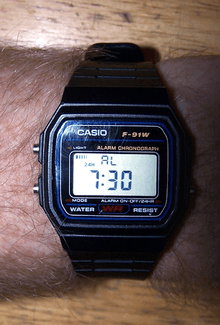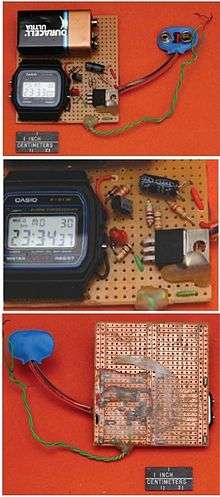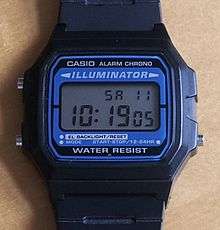Casio F-91W
 | |
| Type | Quartz |
|---|---|
| Display | Digital |
| Introduced | 1991[1] |
The Casio F91W is a quartz digital watch, manufactured by the Japanese company Casio Computer Co., Ltd. It was introduced in 1991 and is still in production and demand.[1] It is popular for its simplicity, reliability and unpretentious, clean design. The watch is available in several variants. Casio does not release sales figures for the model, but admits it continues to sell "well".[1]
Specifications
The F91W has a 1⁄100 second stopwatch with a count up to 59:59.99 (almost one hour). Marking net and split time (lap) is also featured. There are the options of an hourly time beep and a single daily alarm lasting 20 seconds. It has an automatic calendar, although auto-adjustment for leap years is not supported, as the watch does not record the year.[2] The watch uses a green LED backlight located to the left of the display to illuminate it. The light is not very even or bright but is plenty for reading the display easily. The watch is reported to be as accurate as ±30 seconds per month[2] (6 minutes per year) by the manufacturer. As with every quartz movement, certain series of production units are more accurate.
The watch is powered by a single CR2016 3-volt lithium button cell, which will last at least seven years, assuming 20 seconds of alarm and one second of light usage per day. However, these are seldom used in practice, so it is not uncommon that the battery would last even longer. The watch case measures 37.5 × 33.5 × 8.5 mm and weighs 21 g. The manufacturer's module number for this model (stamped on the stainless steel rear of the watch case) is 593.
Water resistance
The watch has a reliable rubber seal between its steel back and case but does not have any seals for its buttons. Since they fit tight enough, surface tension prevents the water from getting inside, but only to a certain point when the pressure will prevail. Therefore, the watch front is marked WATER RESIST,[2] but Casio reports different values for different variants of the watch. The black version (F91W-1XY)[3] is "30 meter / 3 bar", the ISO standard meaning of which is: "Suitable for everyday use. Splash/rain resistant. NOT suitable for showering, bathing, swimming, snorkeling, water related work and fishing", but the colored versions (e.g. F-91WC-2AEF) are "DIN 8310 / ISO 2281- resistant to minor splashing". Even though the black version will resist an occasional water submersion if the buttons are not pressed, the watch should not be used in such conditions on a regular basis.
Operation

The watch is controlled by three side-mounted pushbuttons. The upper left button turns on the backlight, cancels the alarm, resets the stopwatch or marks the split (lap) time, and is used for selecting settings. The lower left button cycles the modes of the watch: time display, alarm, stopwatch, and time/date adjustment. The button on the right is the function button: when used it starts and stops the stopwatch, changes the settings currently being adjusted, or switches between the 12- and 24-hour modes, depending on what mode the watch is currently in. In time mode, pressing this button for three seconds will make the display read "CASIo" if the watch has genuine parts or ones produced under legitimate license. Pressing all three buttons at the same time will fill all the cells on the LCD until any button is pressed again.[4]
The time or date is adjusted by pressing the lower left button three times to bring the watch to time adjustment mode. The top left button is used to cycle through seconds, hours, minutes, month, date, day, and normal mode. The right button is used to adjust the flashing value displayed. Unlike all the other values, the seconds can only be zeroed. Should this happen before :30 seconds, the watch will zero in at the beginning of the current minute. After :30 seconds it will start the next minute as displayed. When the adjustments are finished, the bottom left button can be pressed once to return the watch to normal mode.
The watch display shows the day of the week, day of the month, hour, minute, seconds, and the signs PM or 24H (24-hour clock), the alarm signal status, and the hourly signal status (double beep on the hour).
In stopwatch mode, minutes, seconds and hundredths of a second are shown.
Claimed use in terrorism

According to secret documents issued to interrogators at Guantánamo Bay, obtained[5] and released by The Guardian, "the Casio F-91W digital watch was declared to be 'the sign of al-Qaeda' and a contributing factor to continued detention of prisoners by the analysts stationed at Guantánamo Bay. Briefing documents used to train staff in assessing the threat level of new detainees advise that possession of the F91W – available online for as little as £4 – suggests the wearer has been trained in bomb making by al-Qaeda in Afghanistan."[6] United States Military intelligence officials have identified the F91W as a watch that terrorists use when constructing time bombs.[7][8][9][10][11]
This association was highlighted in the Denbeaux study, and may have been used in some cases at the Guantanamo Bay detention camp.[12] An article published in the Washington Post in 1996 reported that Abdul Hakim Murad, Wali Khan Amin Shah, and Ramzi Ahmed Yousef had developed techniques to use commonly available Casio digital watches to detonate time bombs.[13]
Variants

There are many variants of the F91W that have the same specifications and operational features, including the Casio F105W, which uses an electroluminescent backlight instead of an LED to illuminate the display, the Casio A158W, A159W, A168W, LA680, and B640, with stainless steel bands, and the W59 and F94W.
Interestingly a modification to the F105W can cause the backlight to change colour due to the "blue shift" effect common to ZnS EL. Its possible to do this by wiring a 100K SMD resistor from the sound output transistor base to the EL oscillator set capacitor, and the colour changes from green to blue when the beeper goes off. Some users have also replaced the green/blue EL with a more modern brighter backlight panel based on SrS instead of ZnS.
References
- 1 2 3 Denise Winterman (April 26, 2011). "Casio F-91W: The strangely ubiquitous watch". BBC News magazine. Retrieved April 27, 2011.
- 1 2 3 "F91W-1 Classic Timepiece". Casio. Retrieved April 27, 2011.
- ↑ "F-91W-1XY". Casio. Retrieved May 22, 2013.
- ↑ "Manual" (PDF). Casio. Retrieved November 26, 2014.
- ↑ http://www.theguardian.com/world/interactive/2011/apr/25/guantanamo-files-interrogators-al-qaida-taliban#the-sign-of-al-qaida
- ↑ James Ball (April 25, 2011). "Guantánamo Bay files: Casio wristwatch 'the sign of al-Qaida'". The Guardian. London.
- ↑ "USA v. al Qahtani" (PDF). US Department of Defense. November 7, 2005. Retrieved February 27, 2007.
- ↑ "Combatant status review board for Mohammed Ahmad Said el Edah". The New York Times. October 6, 2004.
- ↑ "Why Am I in Cuba?". Mother Jones. July 12, 2006.
- ↑ "Guantanamo Captives Jailed Because Of Digital Watches". WCVB. March 10, 2006. Archived from the original on February 22, 2007.
- ↑ "Summary of Evidence memo (.pdf) prepared for Sabri Mohammed Ebrahim Al Qurashi's Combatant Status Review Tribunal – page 216" (PDF). October 13, 2004.
- ↑ "Empty Evidence". National Journal. February 3, 2006. Archived from the original on July 4, 2008.
- ↑ R. Jeffrey Smith (July 21, 1996). "New Devices May Foil Airline Security". Washington Post. pp. A01. Retrieved March 14, 2008.
External links
 Media related to Casio F91W at Wikimedia Commons
Media related to Casio F91W at Wikimedia Commons Media related to IED timers that use a Casio f91w at Wikimedia Commons
Media related to IED timers that use a Casio f91w at Wikimedia Commons- F91W-1 product page, Casio website
